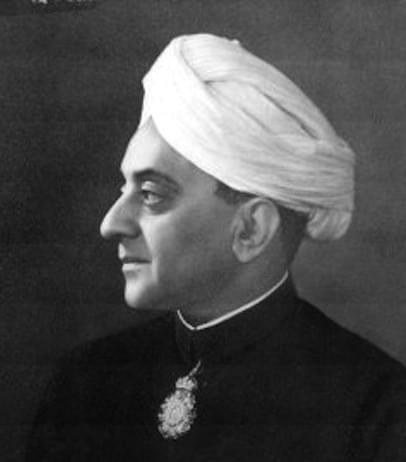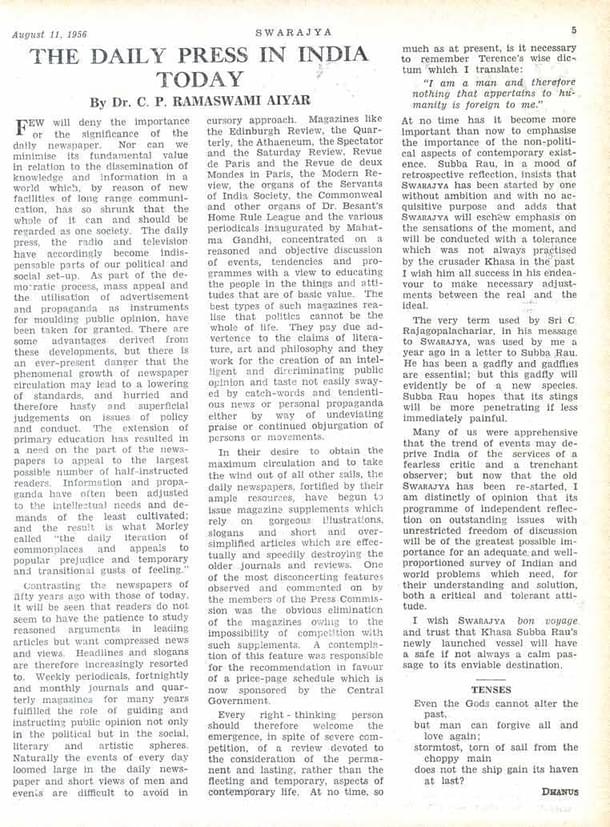Magazine
The Daily Press In India Today
Swarajya Archives
Apr 29, 2015, 09:39 PM | Updated Feb 18, 2016, 12:31 PM IST
Save & read from anywhere!
Bookmark stories for easy access on any device or the Swarajya app.


This piece, by Dr. C. P. Ramaswami Aiyar, was published in Swarajya on 11th of August 1956. It could well have been written in 2015. In it, he rues the lowering of standards of contemporary newspapers. His arguments, sadly and surprisingly, remain as, or are even more, relevant today.
Few will deny the importance or the significance of the daily newspaper. Nor can we minimise its fundamental value in relation to the dissemination of knowledge and information in a world which, by reason of new facilities of long range communication, has so shrunk that the whole of it can and should be regarded as one society. The daily press, radio and television have accordingly become indispensable parts of our political and social set-up. As part of the democratic process, mass appeal and the utilisation of advertisement and propaganda as instruments for moulding public opinion, have been taken for granted. There are some advantages derived from these developments, but there is an ever-present danger that the phenomenal growth of newspaper circulation may lead to a lowering of standards, and hurried and therefore hasty and superficial judgements on issues of policy and conduct. The extension of primary education has resulted in a need on the part of the newspapers to appeal to the largest possible number of half-instructed readers. Information and propaganda have often been adjusted to the intellectual needs and demands of the least cultivated; and the result is what Morley called “the daily iteration of commonplaces and appeals to popular prejudice and temporary and transitional gusts of feeling.”
Contrasting the newspapers of fifty years ago with those of today, it will be seen that readers do not seem to have the patience to study reasoned arguments in leading articles but want compressed news and views. Headlines and slogans are therefore increasingly resorted to. Weekly periodicals, fortnightly and monthly journals and quarterly magazines for many years fulfilled the role of guiding and instructing public opinion not only in the political but in the social, literary and artistic spheres. Naturally the events of everyday loomed large in the daily news-paper and short views of men and events are difficult to avoid in cursory approach. Magazines like the Edinburgh Review, the Quarterly, the Athaeneum, the Spectator and the Saturday Review, Revue de Paris, and the Revue de Deux Mondes in Paris, the Modern Review, the organs of the Servants of the Indian Society, the Commonweal and other organs of Dr. Besant’s Home Rule league and the various periodicals inaugurated by Mahatma Gandhi, concentrated on a reasoned and objective discussion of events, tendencies and programmes with a view to educating people in the things and attitudes that are of basic value. The best types of such magazines realise that politics cannot be the whole of life. They pay due advertence to the claims of literature, art and philosophy and they work for the creation of an intelligent and discriminating public opinion and taste not easily swayed by catch-words and tendentious news or personal propaganda either by way of undeviating praise or continued objurgation of persons or movements.

In their desire to obtain the maximum circulation and to take the wind out of all other sails, the daily newspapers, fortified by their ample resources, have begun to issue magazine supplements which rely on gorgeous illustrations, slogans and short and over simplified articles which are effectually and speedily destroying the older journals and reviews. One of the most disconcerting features observed and commented on by the members of the Press Commission was the obvious elimination of the magazines owing to the impossibility of competition with such supplements. A contemplation of this feature was responsible for the recommendation in favour of a price-page schedule which is now sponsored by the Central Government.
Every right-thinking person should therefore welcome the emergence, in spite of severe competition, of a review devoted to the consideration of the permanent and lasting, rather than the fleeting and temporary, aspects of contemporary life. At no time, so much as at present, is it necessary to remember Terence’s wise dictum which I translate:
“I am a man and therefore nothing that appertains to humanity is foreign to me”
At no time has it become more important than now to emphasise the importance of the non-political aspects of contemporary existence. Subba Rau, in a mood of retrospective reflection insists that SWARAJYA has been started by one without ambition and with no acquisitive purpose and adds that SWARAJYA will eschew emphasis on the sensations of the moment, and will be conducted with a tolerance which was not always practised by the crusader Khasa in the past. I wish him all success in his endeavour to make necessary adjustments between the real and the ideal.
The very term used by Sri C Rajagopalachariar, in his message to SWARAJYA, was used by me a year ago in a letter to Subba Rau. He has been a gadfly and gadflies are essential; but this gadfly will evidently be of a new species. Subba Rau hopes that its stings will be more penetrating if less immediately painful.
Many of us were apprehensive that the trend of events may deprive India of the services of a fearless critic and a trenchant observer; but now that the old SWARAJYA has been re-started, I am distinctly of opinion that its programme of independent reflection on outstanding issues with unrestricted freedom of discussion will be of the greatest possible importance for an adequate and well-proportioned survey of Indian and world problems which need, for their understanding and solution, both a critical and tolerant attitude.
I wish SWARAJYA bon voyage and trust that Khasa Subba Rau’s newly launched vessel will have a safe if not always a calm passage to its enviable destination.
Selections from Swarajya's 40,000 pages of archives since 1956.





